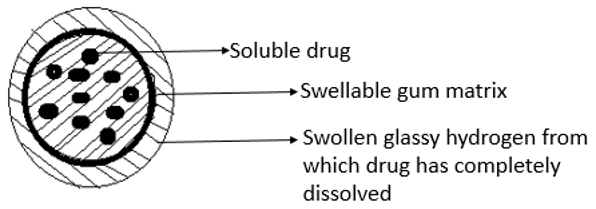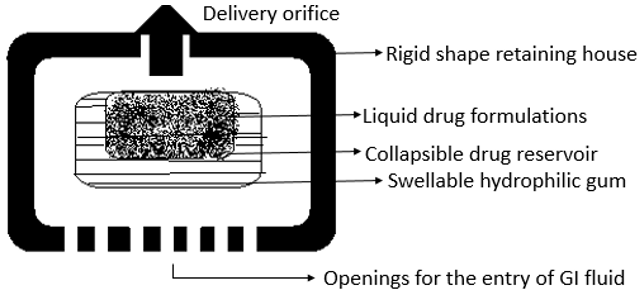This set of Drug Biotechnology Questions and Answers for Campus interviews focuses on “Biopharmaceuticals – Oral Controlled Release Systems – 2”.
1. Which of the following oral controlled release system is shown in the picture?

a) Matrix system
b) Encapsulated system
c) Rigid matrix
d) Swellable matrix
View Answer
Explanation: They are very common and uses waxes such as bees wax, hydrogenated castor oil, etc. They control the drug dissolution rate by controlling the dissolution of the fluid penetration into the matrix. The drug release is often first order from such matrices. The wax embedded drug is prepared by dispersing the drug in molten wax and then granulating them.
2. Which of the following oral controlled release system is shown in the picture?

a) Matrix system
b) Encapsulated system
c) Rigid matrix
d) Swellable matrix
View Answer
Explanation: The drug particles are encapsulated with slowly dissolving particles such as cellulose, PEG, waxes etc. The resulting pellets may be filled in hard gelatin capsules or compressed into tablets. The dissolution rate of the coat depends upon the solubility and thickness of the coating.
3. Which of the following oral controlled release system is shown in the picture?

a) Matrix system
b) Encapsulated system
c) Rigid matrix
d) Swellable matrix
View Answer
Explanation: Rigid matrix are made up of plastics such as PVC or fatty acids such as stearic acid or bees wax. The drug is generally kneaded with the solution in an organic solvent and then granulated. Waxy matrix are prepared and then compressed into tablets.
4. Which of the following oral controlled release system is shown in the picture?

a) Matrix system
b) Encapsulated system
c) Rigid matrix
d) Swellable matrix
View Answer
Explanation: Swellable matrix systems are popular for sustaining the release of highly water soluble drugs. The materials for such matrices are generally hydrophilic gums such as guar gum, polyacrylamide etc. The drug and gum are granulated together with a solvent and then are compressed into tablets.
5. Which of the following oral controlled release system is shown in the picture?

a) Oral osmotic pump
b) Reservoir device
c) Hydrodynamic pressure controlled system
d) Altered density systems
View Answer
Explanation: Reservoir devices are hollow containing an inner core of drug which will be surrounded in a water insoluble polymer membrane. The polymer can be applied by coating or microencapsulation techniques. The drug release mechanism across the membrane involves its partitioning into the membrane with subsequent release int o the surrounding fluid by diffusion.
6. Which of the following oral controlled release system is shown in the picture?

a) Oral osmotic pump
b) Reservoir device
c) Hydrodynamic pressure controlled system
d) Altered density systems
View Answer
Explanation: An oral osmotic pump works on the principle of osmotic pressure to release drug at a constant zero order rate. The core comprises of the drug and osmotically active substances such as potassium chloride or mannitol. This is again surrounded by a rigid semi permeable membrane coating such as cellulose ester.
7. Which of the following oral controlled release system is shown in the picture?

a) Oral osmotic pump
b) Reservoir device
c) Hydrodynamic pressure controlled system
d) Altered density systems
View Answer
Explanation: Hydrodynamic controlled systems are generated by swelling of a hydrophilic gum which will be further used to activate the delivery of drugs. The device comprises of a rigid, shape retaining hosing enclosing a collapsible compartment containing the drug. Such systems are also known as push-pull osmotic pumps.
8. Which of the following oral controlled release system is shown in the picture?

a) Oral osmotic pump
b) Reservoir device
c) Hydrodynamic pressure controlled system
d) Altered density systems
View Answer
Explanation: The picture shown is of high density pellets. This results in prolonged GI residence which will also be unaffected by food. Titanium dioxide, barium sulphate can be used to increase the density of the drug. The drug is coated on the heavy core and then covered by a diffusion controlled membrane.
9. What is the characteristics of altered density systems?
a) Release the drug along the entire length of GIT
b) Prolonged their residence in the GIT and release
c) Release only at a specific drug
d) Use of high or low density pellets
View Answer
Explanation: The GI transit time is less than 24 hrs. Thus the density of the drugs changes such that the frequency of dosing can be reduced. The use of altered density approach use either high or low density pellets. These are hydrodynamically balanced systems. Titanium dioxide, barium sulphate can be used to increase the density.
10. What are the characteristics of floating or buoyant capsule systems?
a) Release the drug along the entire length of GIT
b) Granule drug with hydro gel
c) Release only at a specific drug
d) Use of high or low density pellets
View Answer
Explanation: Floating of buoyant capsules are formulated by granulating a drug with 20-80% of hydrogel. On contact with the GI fluids these tablets swells and forms a diffusible gel that lowers the density of the system allowing it to float. Or a gas filled floatation chamber can be attached to a membrane coated tablet for making it buoyant.
11. What is the characteristics of mucoadhesive systems?
a) Release the drug along the entire length of GIT
b) Prolonged their residence in the GIT and release
c) Usage of bio adhesive polymer
d) Use of high or low density pellets
View Answer
Explanation: Bio adhesive polymers when they are used as a cross linked polyacrilic acid and are incorporated in a tablet, it allows it to adhere to the gastric mucosa or epithelium. Such a system continuously releases a fraction of drug into the intestine over prolonged period of time increasing the pharmaco therapeutic time.
12. Enteric coating are used for which systems?
a) Intestinal release systems
b) Colonic release systems
c) Size based systems
d) Mucoadhesive systems
View Answer
Explanation: Enteric coating are used for intestinal release systems such that these coating only gets dissolved in the intestinal pH. The drug gets absorbed by two mechanisms chylomicrons entrap hydrophobic drugs and pinocytes uptake macromolecules. Colonic release systems use polymers which gets dissolved in the pH range of colon.
13. Drugs cannot be delivered to the colon.
a) True
b) False
View Answer
Explanation: Drugs are poorly absorbed through the colon but can be delivered to the colon. It is used for the treatment of ulcerative colitis, systemic absorption of insulin and vasopressin like peptides. Also can use divinylbenzene polymers which will be cleaved by azoreductase.
14. What are the characteristics of intestinal release systems?
a) Release the drug along the entire length of GIT
b) Prolonged their residence in the GIT and release
c) Usage of polymers that dissolves only in the alkaline pH of colon
d) Use of enteric coating
View Answer
Explanation: A drug to make it release only in the intestine are enteric coated. The reason of such drugs to prevent gastric irritation, prevent destabilisation in gastric pH. Selective release of the drugs to Peyer’s patch of intestine prevents them from getting destroyed by the intestinal enzymes.
15. What are the characteristics of colonic release systems?
a) Release the drug along the entire length of GIT
b) Prolonged their residence in the GIT and release
c) Usage of polymers that dissolves only in the alkaline pH of colon
d) Use of enteric coating
View Answer
Explanation: For the drug to be released in colon pH sensitive bio erodible polymers like polymethacrylates are used. These polymers release the medication only at the alkaline pH of colon. These are used for the treatment of ulcerative colitis. Also can use divinylbenzene polymers which will be cleaved by azoreductase.
Sanfoundry Global Education & Learning Series – Drug and Pharmaceutical Biotechnology.
To practice all areas of Drug Biotechnology for Campus Interviews, here is complete set of 1000+ Multiple Choice Questions and Answers.
If you find a mistake in question / option / answer, kindly take a screenshot and email to [email protected]
- Apply for Biotechnology Internship
- Practice Biotechnology MCQs
- Check Drug and Pharmaceutical Biotechnology Books
- Check Biotechnology Books
